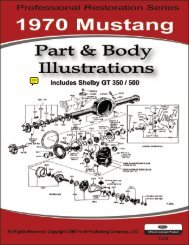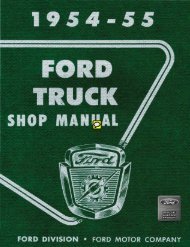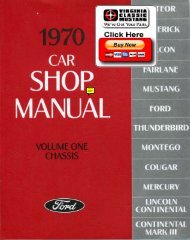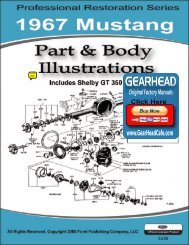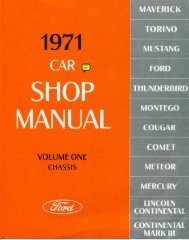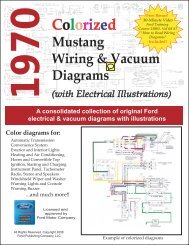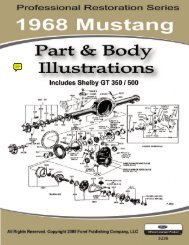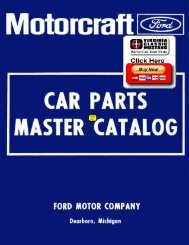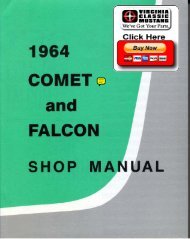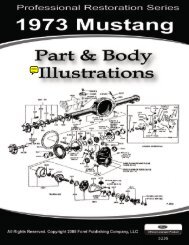DEMO - 1965 Ford Truck Shop Manual - ForelPublishing.com
DEMO - 1965 Ford Truck Shop Manual - ForelPublishing.com
DEMO - 1965 Ford Truck Shop Manual - ForelPublishing.com
Create successful ePaper yourself
Turn your PDF publications into a flip-book with our unique Google optimized e-Paper software.
2-4 GROUP 2 - BRAKES<br />
DIAGNOSIS GUIDE—POWER BRAKES VACUUM BOOSTERS—FRAME MOUNTED—(Cont'd)<br />
ROUGH ENGINE IDLE OR<br />
STALL AND HARD PEDAL<br />
WITH BRAKES APPLIED<br />
valve plate, or the control valve pis-<br />
ton not seating properly on the plate<br />
may also cause this condition. In ad-<br />
dition, the booster diaphragm may<br />
be damaged. Remove and overhaul<br />
the booster assembly.<br />
Check the condition of the air<br />
cleaner. If it is clogged with dirt, replace<br />
the air cleaner felt. A sticking<br />
control valve piston, leaks at the<br />
control valve diaphragm or atmospheric<br />
valve seal, dirt on the control<br />
INTERMITTENT HARD<br />
BRAKE PEDAL<br />
Check for an obstructed air clean- draulic fluid. Clean or replace darner,<br />
a defective vacuum check valve, aged parts, refill the hydraulic sysor<br />
a slave cylinder piston sticking in tem with new heavy-duty type brake<br />
the bore due to dirt or inferior hy- fluid, and bleed the system.<br />
HARD PEDAL—BOOSTER<br />
DIAPHRAGM RUPTURED<br />
Gasoline can get on the diaphragm<br />
from the intake manifold if the vac-<br />
uum check valve is defective or if<br />
hoses are not routed correctly,<br />
When a ruptured diaphragm is<br />
found, check for gasoline odor on<br />
the diaphragm. Gasoline will deteriorate<br />
the diaphragm and cause a<br />
premature failure.<br />
BRAKES DO NOT<br />
RELEASE<br />
In case of emergency, if a sticking<br />
control valve piston holds the brakes<br />
in an applied position, disconnect the<br />
booster vacuum line from the vac-<br />
uum check valve and install a pipe<br />
plug in the check valve opening,<br />
This permits the brakes to release,<br />
<strong>Manual</strong> application of brakes may<br />
then be made without assistance<br />
from the booster.<br />
Check the rear of the vacuum<br />
chamber for damage. This condition<br />
may also be caused by a sticking<br />
control valve piston, a faulty slave<br />
cylinder piston check valve, dirty<br />
brake fluid, a sticking slave cylinder<br />
piston, a sticking push rod, or a<br />
faulty check valve in the end cap.<br />
Remove and overhaul the booster.<br />
DIAGNOSIS GUIDE—POWER BRAKES VACUUM BOOSTER—MIDLAND DASH MOUNTED<br />
BOOSTER INOPERATIVE<br />
HARD PEDAL<br />
Check as follows to see if the Brake pedal linkage sticking,<br />
power unit is operating: With the Faulty vacuum check valve,<br />
engine stopped, depress the brake Collapsed or leaking vacuum hose,<br />
pedal several times to eliminate all plugged vacuum fittings,<br />
vacuum from the system. Apply the Leaki yacuum chamber.<br />
brakes, and while maintaining pres- Vacuum ^ stuck<br />
sure on the pedal, start the engine. , , • ...<br />
m<br />
If the unit is operating, the brake closed position,<br />
pedal will move forward slightly Leak in bellows assembly,<br />
when engine vacuum power is added Diaphragm assembly out of place<br />
to the foot pressure on the pedal. If in housing locating radii:<br />
the unit is not operating, there will Vacuum leak in automatic transbe<br />
no pedal action.<br />
mission T.V. vacuum line connection<br />
If this check shows that the unit or fitting,<br />
is not operating, check for the fol- Vacuum leak in forward, vacuum<br />
lowing:<br />
housing.<br />
BRAKES DRAG<br />
BRAKES GRAB<br />
SELF APPLICATION OF<br />
BRAKES WHEN ENGINE<br />
STARTS<br />
Sticking valve plunger.<br />
Sticking actuating valve assembly.<br />
Leak in rear housing.<br />
pheric pressure into rear chamber.<br />
Diaphragm out of locating radii Sticking or unseated atmospheric<br />
in housings and allowing atmos- valve.<br />
CONTINUED ON NEXT PAGE




